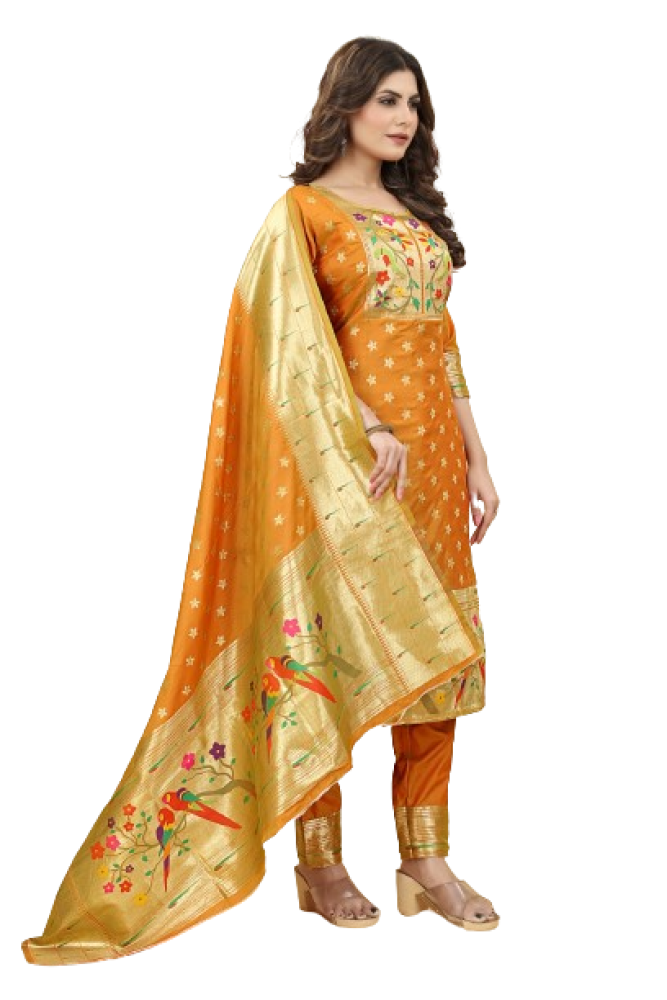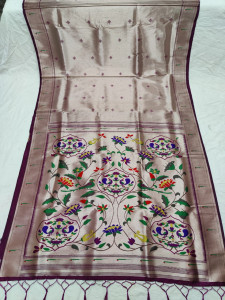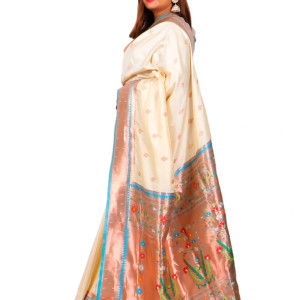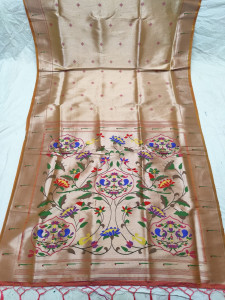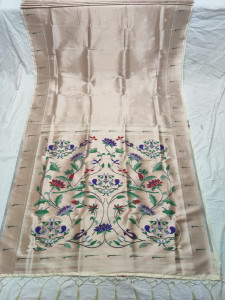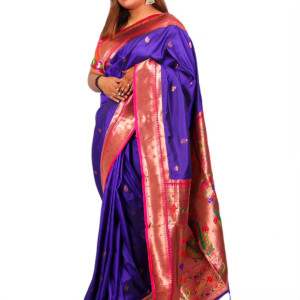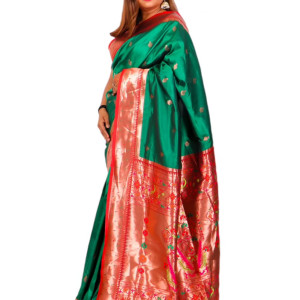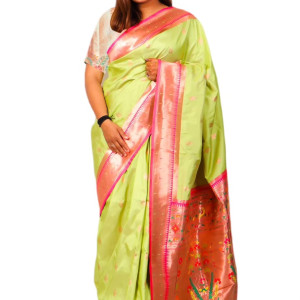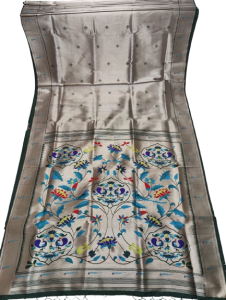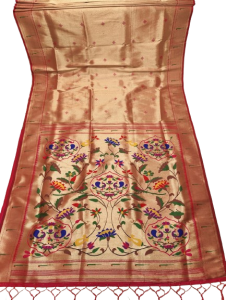Paithani Suit Yellow Colour
Add a touch of vibrancy to your look with our Paithani Suit in Yellow. The bright yellow hue, paired with traditional Paithani motifs, creates a striking ensemble. Crafted with attention to detail, this suit is perfect for adding a pop of color to your ethnic wardrobe.
- • GI Origin : Maharashtra
- • Fabric Material : Pure Mulberry Silk Yarn & Zari
- • Product Material : Unstiched
- • Top Length : 46
- • Bottom Length : 24
- • Dupatta Length (H x W) : 85
- • Weight : ~ 300grams
- • Colour : Yellow
- • Care Instructions : Hand wash with mild detergent, dry clean recommended, avoid direct sunlight
- • Product GI Certificate No : 130
Goods Description:
Paithani Sarees/Fabrics, in particular, feature borders with an oblique square design and a pallu adorned with a peacock motif. The design incorporates linear and exquisite frameworks with intricate gold-woven motifs of floral birds, notably peacocks, parrots, and maina forms, on the pallav and border. The front and back of the saree appear similar due to the tapestry method of weaving. These Sarees/Fabrics often use silk thread with twisted silver coated with gold (jari), or sometimes twisted zari on cotton thread. Common motifs found in the Pallu include 'Asawali,' 'Panja' (a geometrical flower), 'Muthada' (a geometrical shape), and 'Mor' (peacock). Paithani Sarees/Fabrics come in various colors, with delicate shades giving them a distinct touch, achieved through pure colors or blends of different yarns.
Geographical Production Area:
Paithani Sari & Fabrics are primarily produced in Paithan Taluka of Aurangabad District and Yeola Taluka of Nashik District in Maharashtra, India. Paithan, situated 56 km south of Aurangabad, was the capital of the Satavaanas Empire from the 2nd century BC to the 2nd century AD. Yeola, located about 85 km east of Nashik, is part of the Niphad Sub-Division of Nashik District.
Proof of Origin:
Historical records trace the crafts of Paithan back to the 6th century BC. The Satavahanas played a significant role in documenting and fostering the craft, sending ambassadors to Western countries to understand and trade fabrics. Paithan flourished as a trade center, attracting attention from writers like Pliny, Ptolemy, and Periplus. Recent archaeological findings validate these historical accounts, affirming Paithan's rich heritage as an international silk and zari trading hub during the Satavahanas dynasty.
Production Process:
The production process involves several stages:
Raw Materials: Mulberry silk yarn is sourced from Bangalore, comprising twisted silk for warp ("Taana") and softer silk for weft ("Baana"). Zari, used for warp and weft, is procured from Surat, Gujarat. Modern chemical dyes are obtained from Mumbai.
Paithani Weaving Technique:
The intricate process includes sorting silk, degumming, bleaching, dyeing, winding, and actual weaving. Silk is sorted, wound, and manually warped onto frames. Degumming involves soap and soda treatment to remove silk gum, followed by bleaching with hydrogen peroxide. Dyeing employs various classes of dyes, predominantly acid dyes.
Winding:
After dyeing, the yarn is wound onto cones for weft or bobbins for warp, manually or using machines.
Weaving:
Weaving is done on traditional wooden looms, with techniques varying for different types of Paithani Sarees/Fabrics: fly shuttle weaving, throw shuttle weaving, and cut shuttle weaving.
Finishing:
Completed Sarees/Fabrics are cut, folded, and packed for distribution.
Designing and Embroidery:
Paithani motifs draw inspiration from nature, including flora, fauna, and religious themes. Extra-weft embroidery techniques are employed manually, contributing to the intricate designs.
Uniqueness:
Paithani Sarees/Fabrics are renowned for their unique craftsmanship. Woven without mechanical aids like jacquards, skilled artisans meticulously count warp threads and interlock them with weft using tiny cloth pirns or "Tillies." The Sarees/Fabrics feature intricate borders and Pallavs, with motifs reflecting regional influences, such as those from Ajanta caves. The combination of silk and zari, along with traditional designs, makes Paithani Sarees/Fabrics highly coveted, symbolizing Maharashtra's rich cultural heritage.
On 3rd September 2010 Paithani Sarees/Fabrics received the GI (Geographical Indication) certificate.

 EUR
EUR INR - ₹
INR - ₹
 USD - $
USD - $
 CAD - Can$
CAD - Can$
 GBP - £
GBP - £
 SGD - S$
SGD - S$
 AUD - A$
AUD - A$
 MYR - (RM)
MYR - (RM)
